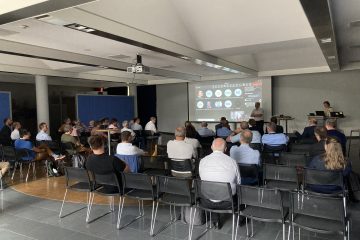On 15 April 2023, the last operating nuclear power plants in Germany were taken off the grid, marking the end of the era of using nuclear energy to generate electricity in this country. This raises the question of whether it will still be worth switching to the nuclear energy sector or starting a career in this industry in 2023.
This is probably one of the questions that prompted the participants of the KTG excursion "Northwest" to join this excursion, as the excursion was aimed specifically at career changers and young professionals.
The aim of the excursion was to impart practical knowledge in nuclear fuel cycle facilities, taking care to show the entire spectrum of the nuclear fuel cycle within just one week. The week, which was therefore packed with information, began for us participants on Monday, 18 September 2023, in Gronau.
The beginning of the excursion coincided with the start of the nuclear fuel cycle, as the nuclear fuel cycle began in Gronau. Urenco Germany GmbH visited a uranium enrichment plant.
But first, we started with lunch, which gave the participants the opportunity to get to know each other. After all, most of the participants would be spending the next five days together around the clock. (It was also possible to participate only on Monday and Tuesday or from Wednesday to Friday). There were fellow travellers from all areas of the nuclear industry, so the knowledge levels on the various topics on the agenda could hardly have been greater.
After the welcome address by Mr Andreas Meyering, manager of the plant, Urenco was presented at the first lecture of the week by Mr Stefan HeckenmüllerHead of Maintenance. Both the entire Urenco Group and the Gronau site in particular were discussed. On the very first day, it became clear that the shutdown of nuclear power plants does not mean the end of nuclear technology in Germany.
On the contrary: Urenco is currently investing heavily, partly to compensate for the loss of Russian nuclear fuel (due to the war in Ukraine and the associated embargoes).
During the subsequent tour of the plant, we were able to gain an insight into the enrichment process.
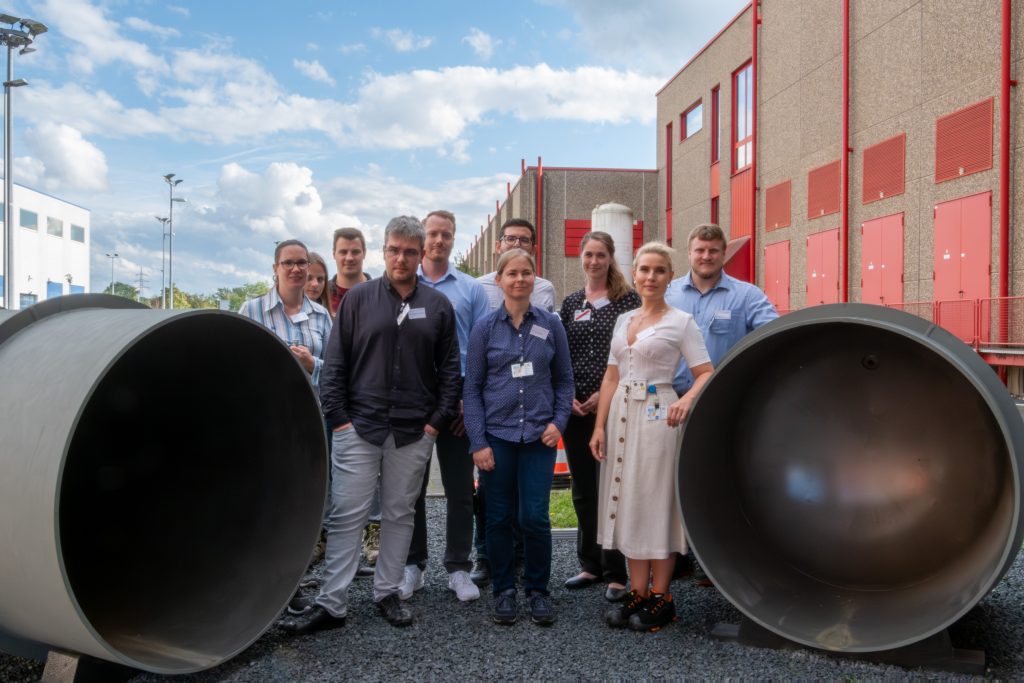
After visiting the facility, we set course for the first hotel. Between checking into the hotel and dinner, there was still time to freshen up. But dinner was not the end of the day, because after dinner there was another exciting lecture.
This schedule was to be repeated over the next few days, so that the site visits were supplemented by lectures that provided insights into a wide range of nuclear technology topics. As a result, the packed days only ended after 9 pm.
On Monday, the presentation by Mrs Sara Beck from the Society for Plant and Reactor Safety (GRS) SMRs (Small Modular Reactor). The various reactor types were reported on and the advantages and disadvantages of SMRs compared to larger nuclear facilities were highlighted. In view of the current worldwide endeavours in the direction of SMRs, these could therefore be a technology of the future, even if the technology itself - in nuclear time measurements - is quite old, as the example of the cargo-carrying nuclear ship Otto Hahn shows.
The next morning, after breakfast, we went straight on to the Advanced Nuclear Fuels GmbH in Lingen, where not only the next tour, but also the next step in the nuclear fuel cycle awaited us. How Dr Hendrik WieselManager Competence.hub, reported in his welcoming speech, Advanced Nuclear Fuels GmbH in Lingen is one of the few plants in the world that is able to manufacture fuel assemblies individually according to customer requirements and thereby fulfil the high quality standards of the customer.
guaranteed.
A guided tour of the plant showed the process from the delivery of the enriched uranium hexafluoride to the finished fuel element.
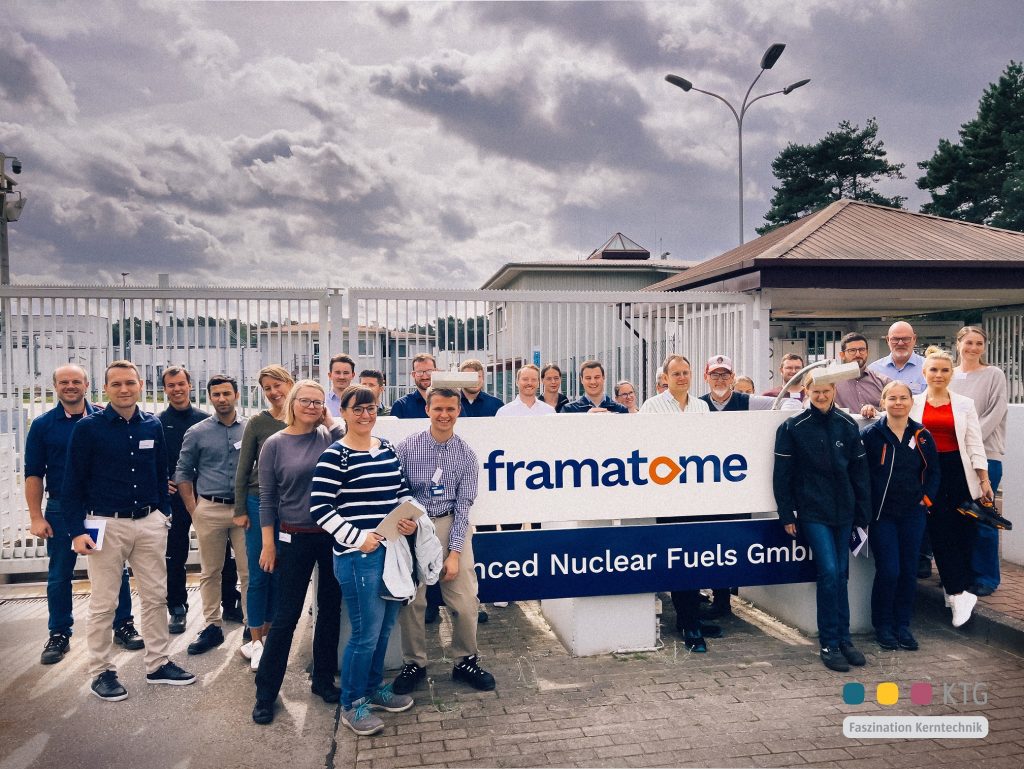
For lunch on Tuesday we went on to the Emsland nuclear power plant (KKE), where the welcome in the information centre by the manager of the plant Mr. Wolfgang Kahlert took place before a specialist presentation on the topic of "Innovation at RWE Nuclear". In this, new technologies were presented that RWE uses in the dismantling of its plants. In particular, the fully automated systems for paint stripping with ultra-high water pressure (ROBBE), a process for decoating with LASER and a self-running robot for the automatic measurement of surface contamination were presented.
During the subsequent tour of the outer safety area, the otherwise cheerful group felt a little uneasy for the first time. At the highlight of the tour in the nacelle, the prevailing silence was perceived as unusual and unpleasant by everyone who had ever stood in the turbine corridor of a running plant. It was immediately apparent that the shutdown of the KKE was less than six months ago and that people had not yet fully familiarised themselves with the new state of the plant.

By dinner, the mood, which had dampened in the meantime, had lifted again and just in time for dessert, Mr Heiko EisertSite Development, Special Projects & GAS Support, reported on RWE's plans for the future at the Lingen site.
The presentation was dominated by the topic of hydrogen, which, alongside mega-batteries for example, is set to play a key role in determining the future of the site. In addition to hydrogen refuelling stations and feeding into the gas grid, the production of CO2-free steel was also reported on. On this evening, too, the subsequent discussion showed that although one gets very tired (after a tight 12-hour schedule with a constant stream of new impressions), the excitement of the presentations clearly outweighs this.
Wednesday started with a long bus journey and was thematically a leap into the future, so to speak, because after the KKE plant, which had just been taken offline, a visit to the Stade nuclear power plant (KKS). Demolition work is currently being carried out on the first buildings in the monitoring area of the KKS and work on the reactor building is almost complete. This was impressively demonstrated during the inspection of the empty containment vessel, which has not only been stripped of all concrete structures, but also of most of the paint. This stripping was carried out with the help of magnetic crawlers on the smooth inner surface of the sphere, which had previously been stripped of interfering edges. It was also possible to see the advanced
Viewing the building release. On the KKS site, it became clear that demolition also means new construction, as the tour of the "works yard" led to an area that was not even part of the power plant site when it was in operation.
A concluding presentation by the manager of the plant, Mr Marco Albers summarised the dismantling of the nuclear facility once again and showed, among other things, impressive video material of the removal of the calotte material with a special excavator.
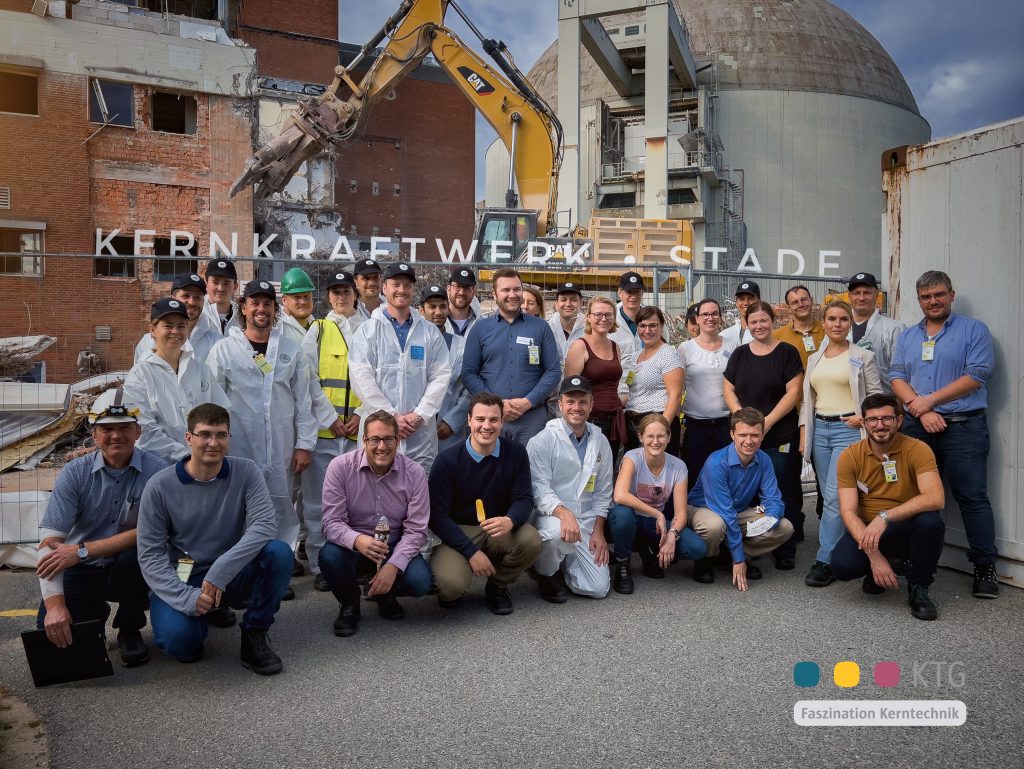
The evening lecture was given on Wednesday by Mr Michael BongartzManaging Director of PreussenElektra, spoke on the topic of decommissioning planning at PreussenElektra. The timetable for the various decommissioning projects at the power plant sites was discussed.
of PreussenElektra. He also addressed the various challenges
at the locations and showed the current condition of the facilities.
This presentation also made it clear that the shutdown of the power plants is by no means the end of the sites, but that the dismantling of the nuclear power plants will create space for something new and a subsequent use as an energy site is being sought.
Thematically, the excursion now moved towards waste disposal and final storage; physically, we travelled to Bassum to the Eisenwerk Bassum GmbH. There we start the Thursday with a presentation by the managing director Mr Alexander Beckedorf and Mr Holger Rüchel, Head of Project Management, to Gesellschaft für Nuklear- Service mbH (GNS), focussing on the subsidiary Eisenwerk Bassum GmbH.
This is where the "Konrad containers" are manufactured, which are required for final storage in the Konrad mine. In addition to an impressive insight into steel production, the subsequent factory tour showed that this site is also under construction and not in the process of being dismantled. Large factory halls were moved from the neighbouring site to
in order to further increase production capacity for the "Konrad containers".
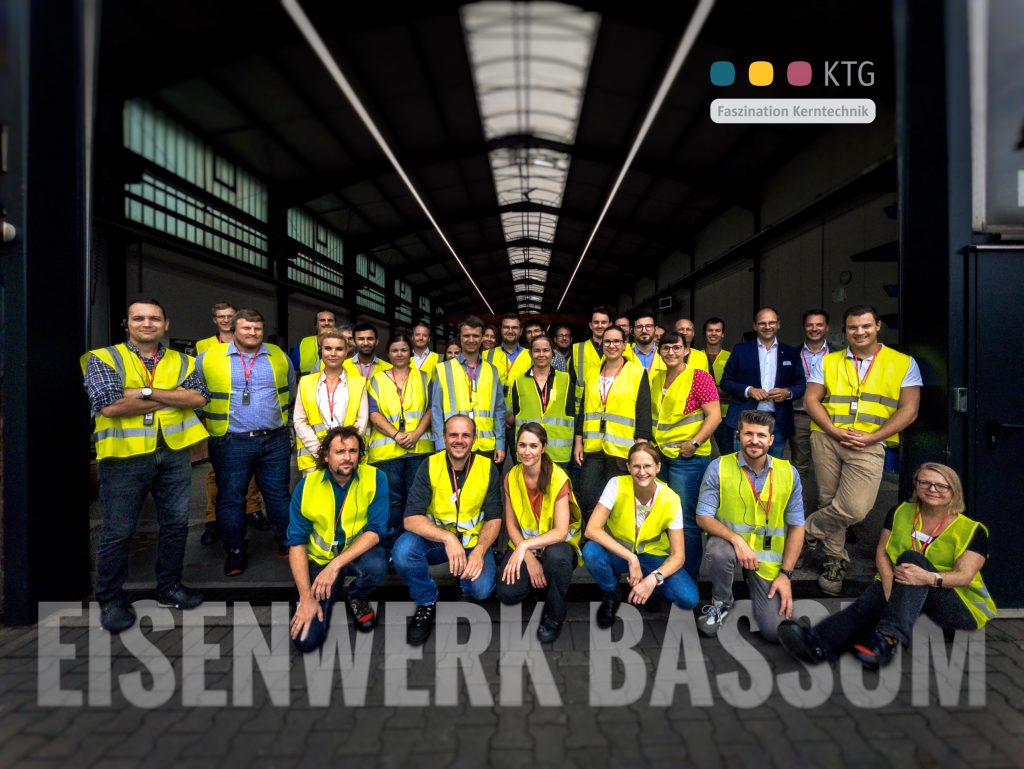
By shutting down all nuclear power plants in a comparatively short period of time,
the light and medium-level radioactive waste also accumulates over a short period of time, so that the
demand for "Konrad containers" skyrockets. Capacities must be increased to up to 1,500
containers per year, with one of the main challenges being the customised container fittings. Depending on customer requirements, these have to be specially customised for the parts to be stored, meaning that almost every container is unique.
After the factory tour, we travelled by bus in the direction of the Konrad mine, where we were first given a theoretical overview of the site that evening. Andreas Reichert the Federal Company for Final Disposal (BGE) a presentation was given on the entire BGE. It not only reported on the various sites and their challenges, but also on the search for a site for the federal repository for high-level radioactive waste. It became clear,
that there will still be a lot of work to be done in the field of nuclear technology in the coming decades. In addition to the emptying of the Asse site, there was also a report on the preparations for the start of storage at the Konrad mine, which we were able to visit on Friday.
During the guided tour of the plant Shaft Konrad It quickly became apparent that nuclear technology and mining go hand in hand here, so we had to get used to new terms such as Kaue (changing room) or Lutte (supply or exhaust air pipe).
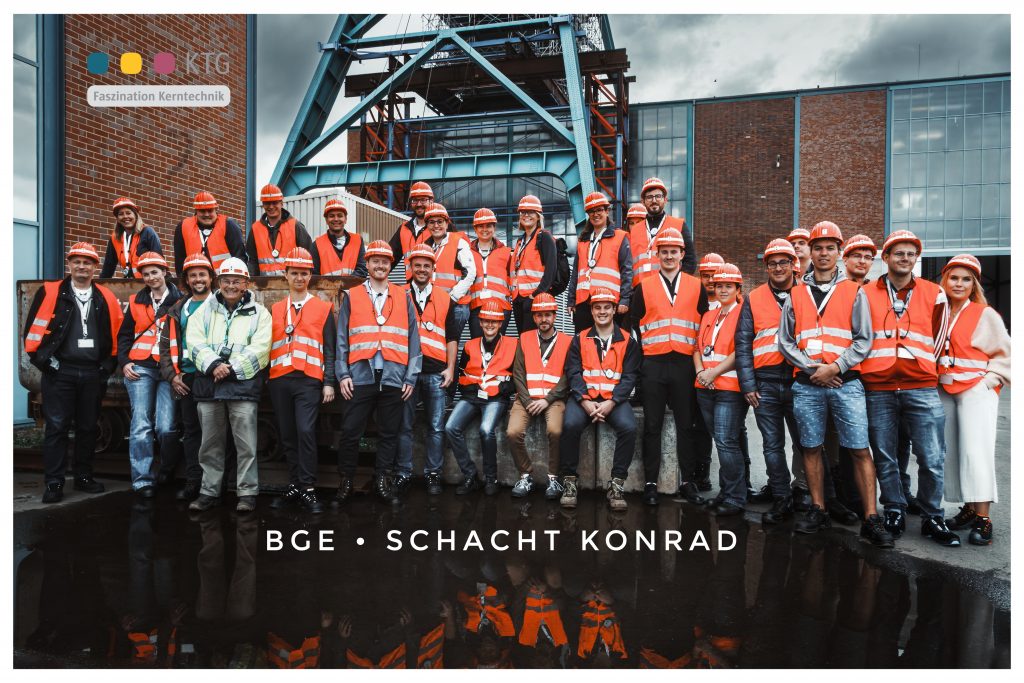
The site of Shaft 1 is dominated by the listed headframe, which is used to transport miners and equipment to create the underground infrastructure. A logistics centre and a new headframe are currently being built at Shaft 2, which will be used to transport waste to the underground control area during operation. Our excursion ended at the information centre
of the BGE in the centre of Salzgitter, where we could at least virtually drive into the shaft.
This marked the end of our tour of northern Germany at the repository, where a large part of the
of radioactive waste will end. During the week, an arc was drawn from the beginning of fuel production with the enrichment of uranium hexafloride, the production of fuel rods and fuel elements, to the now ended operation of the nuclear power plants, their dismantling and the final storage in the containers provided for this purpose.
The excellently organised tour showed the participants the individual stations in a practical way
and managed to present the colourful variety of topics in a way that was understandable for beginners and yet exciting for the more advanced. Although many of the participants were exhausted at the end of the week and looking forward to going home to bed, there were always calls for the next excursion, perhaps next time in the south, east or west of Germany.
Everyone has to decide for themselves whether it makes sense to switch or start a career in the nuclear energy sector, but this excursion clearly demonstrated this: There will be enough tasks in nuclear technology for a long time to come.


